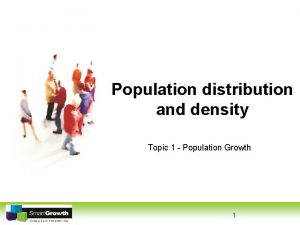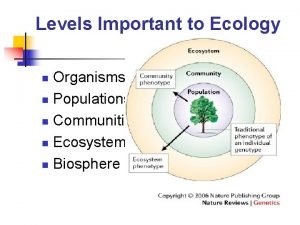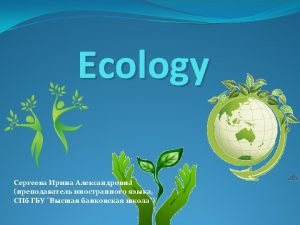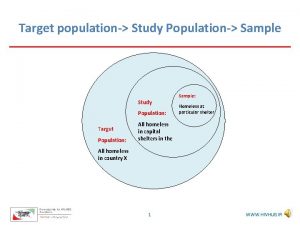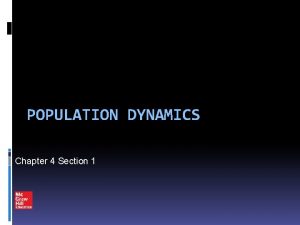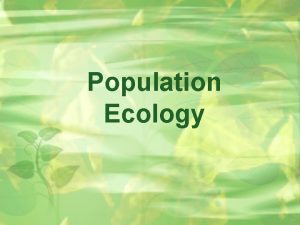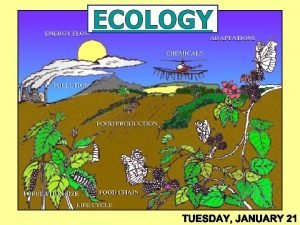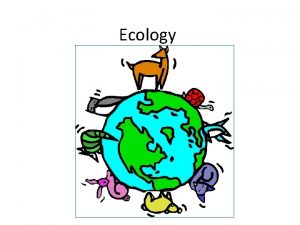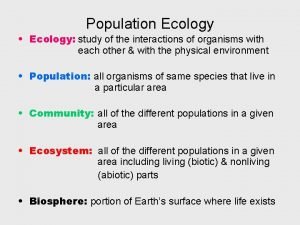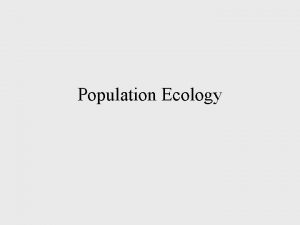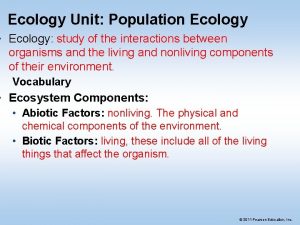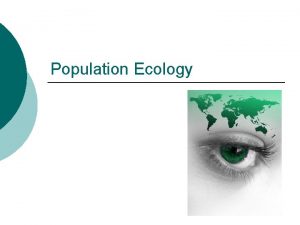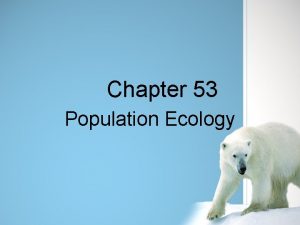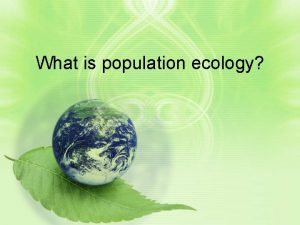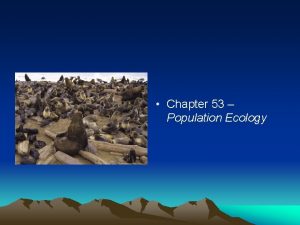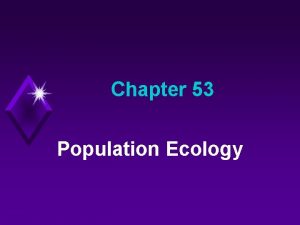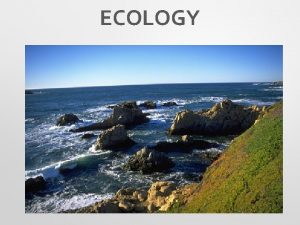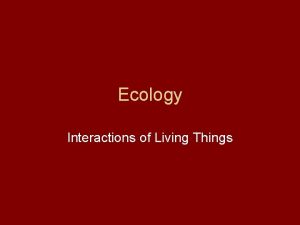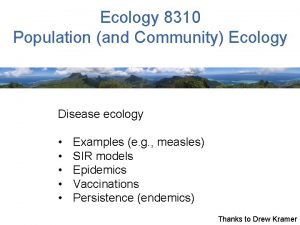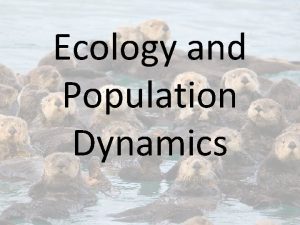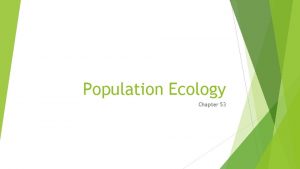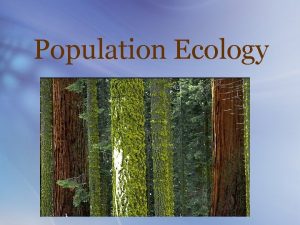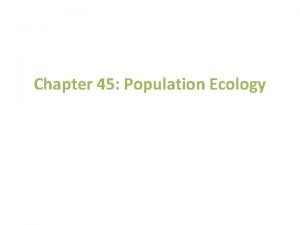Population Ecology Def Study of the interactions of





























- Slides: 29

Population Ecology Def – Study of the interactions of organisms with their physical environment & with each other • Organism - Individual of a particular species • Population – Group of individuals of one species living in one area who are able to • • interbreed and interact with each other Community – All populations living in one area Ecosystem – all the organisms in a given area & the abiotic (non-living) factors with which they interact • Biome – large geographical area with unique climate defined by distinctive communities of plants & animals i. e. desert, tundra, rainforest • Biosphere – global ecosystem…the Earth “BBECPO”

Population Properties • 5 Properties 1. Size – Total number of individuals in a population -- Typically represented by N 2. Density – The number of individuals per unit area/volume -- Here we are measuring not population size but how closely packed they are into an area -- For example: which population is more dense: Manhattan’s or Weston’s? -- Sampling techniques used to estimate the number of organisms living in an area -- One sampling technique is called mark & recapture

Mark & Recapture Method • Sampling technique used to estimate population size • Organisms are captured, tagged, then released • Then at some future time, the process is repeated • Example: 1 st catch: 50 whippets tagged 2 nd catch: 100 whippets captured, but only 10 tagged Population Estimate = 500 whippets

Population Properties cont’d 3. Dispersion – Pattern of spacing of individuals within the area the population inhabits a) Clumped -- Most common pattern of dispersion -- Pack animals b) Uniform -- Animals that defend their territories -- Certain plants which secrete toxins that keep away plants that compete for the same resources c) Random -- Spacing occurs in absence of any spatial factors -- Uncommon pattern in nature -- Tree spacing in a forest other


Population Properties (Page 3) 4. Survivorship Curve (Mortality Curve) -- Show the size & composition of a population -- 3 basic types a) Type I -- Low death rates in young & middle age -- High mortality in old age -- Humans b) Type II -- Constant death rate over entire life span -- Hydra, reptiles, & rodents c) Type III -- High death rate among young, but then slows -- Fish & Invertebrates (external fertilization)

Survivorship Curves

Population Properties (Page 4) 5. Age Structure Diagrams -- Shows relative number of individuals at each age

Age Structure Diagrams • Curve I – Afghanistan – – Pyramidal shape Bottom heavy or majority of population is young May indicate future population explosion Alternatively, may indicate population pressure • The majority of population will die young • Curve II – USA – Stable population – Experiencing little or zero population growth – Birth & death rates are equal = numbers in each age group is the same

Population Growth • Biotic Potential – Maximum rate at which a population could increase under ideal conditions – Maximum reproductive capacity of a population under optimum environmental conditions. • As should be evident, this is probably never true – If true, it will only exist briefly – Used more for comparison to the actual situation

Exponential Population Growth • Simplest model for population growth is exponential growth – – – Represents unrestrained growth Unlimited resources No predation/parasitism No competition No immigration/emigration • Example: introduction of a foreign organism into a stable ecosystem – Humans have experienced exponential growth for ~300 yrs.

– Does population growth continue without limits? • Number of resources usually prevent populations from growing exponentially • Carrying capacity (K) = maximum number of individual that an environment can support – When population reaches carrying capacity » birth rate = death rate » population growth rate = 0

Predicting Population Growth

• Population growth – Logistic growth model • Population growth rates decreases as population approaches its carrying capacity Adjustment for limited resources Population size Per capita growth rate Population growth rate

• Population growth – Logistic growth model • Logistic growth produces S-shaped curve; population growth rate decreases as N approaches K Population size (N) K Time (t)

Examples of logistic growth Where have all the sea otters gone?

• Population growth – How does logistic growth model work? • When N is very small (imagine N is 1 and K is 1000). . . is close to 1, so population grows exponentially (1) Population size (N) Time (t)

• When N approaches K (imagine N is 500, 600, . . . 900 and K is 1000). . . Gets closer and closer to 0, so population growth slowly approaches 0 Population size (N) Time (t)

• When N equals K (imagine N is 1000 and K is 1000). . . is 0, so population growth is 0 Population size (N) Time (t)

Actual Population Growth Models Characteristic Overshot

– Density-dependent population regulation • As populations near carrying capacity…population growth rate declines – Per capita birth rates decrease (fewer resources available for production of offspring) » fewer resources available for production of offspring – Per capita death rates increase (fewer resources for survival, predators focus attention on common prey) » fewer resources for survival » predators focus attention on common prey

– Density-dependent factors include: • disease • predators • competition for resources

• Population growth – Sometimes population regulated by densityindependent factors • Birth rates decrease and death rates increase regardless of population size – Extremely cold winter – drought – fires

r- and K-selected life history traits Life History - an organism’s schedule of reproduction and survival trait r-selected K-selected – age at 1 st reproduction early late – lifespan short long – Survivorship low (type III) high(type I) – Fecundity high low – Offspring size small large – Parental care none lots

Typical Populations • Boom-and-bust cycles are common in populations over time – Due to complex interactions between biotic and abiotic factors

Predator-Prey Relationships --Exponential Growth then crash -- Lynx population follows the hare pop. -- Cycles in hare due to food availability (grass overgrazing), disease, or predation -- Cycles in Lynx due to hare availability

Human Populations • Until 1650, human populations were very low growth • Humans have experienced high growth rates since about 1650 • Since 1970 s, population growth has decreased over time

Demographic Transition

Ecological Footprint • Proxy measure of carrying capacity • Total land + water area needed for all the resources 1 person consumes in a population • 1. 7 hectares person = sustainable usage • In the US, 10 hectares person is typical
 Population ecology def
Population ecology def Chapter 4 section 1 population dynamics study guide
Chapter 4 section 1 population dynamics study guide Population ecology section 1 population dynamics
Population ecology section 1 population dynamics Population ecology section 1 population dynamics
Population ecology section 1 population dynamics Population ecology section 1 population dynamics answer key
Population ecology section 1 population dynamics answer key Clumped dispersion
Clumped dispersion Logistic growth equation population ecology
Logistic growth equation population ecology 52
52 Ecosystem vs community
Ecosystem vs community Concept 3 population ecology
Concept 3 population ecology Chapter 53 population ecology
Chapter 53 population ecology Equilibrial life history
Equilibrial life history Chapter 4 population ecology answer key
Chapter 4 population ecology answer key Chapter 53 population ecology
Chapter 53 population ecology Characteristic of population
Characteristic of population Section 1 population dynamics answer key
Section 1 population dynamics answer key Population characteristics
Population characteristics What is population ecology
What is population ecology Population definition ecology
Population definition ecology Population distribution
Population distribution Population ecology
Population ecology Chapter 53 population ecology
Chapter 53 population ecology Biology ecology study guide answer key
Biology ecology study guide answer key Chapter 3, section 1: community ecology answer key
Chapter 3, section 1: community ecology answer key Ecology is the study that helps to preserve
Ecology is the study that helps to preserve What is a study population
What is a study population Study population
Study population Whats a density independent factor
Whats a density independent factor Hình ảnh bộ gõ cơ thể búng tay
Hình ảnh bộ gõ cơ thể búng tay



















